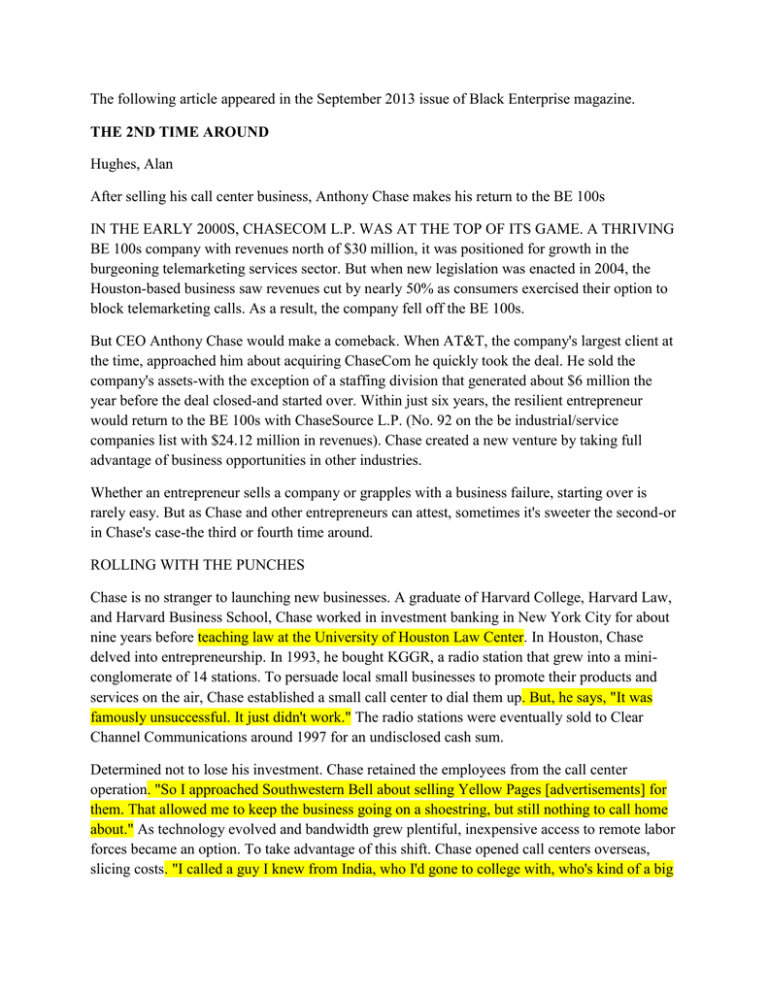The following article appeared in the September 2013 issue of... Hughes, Alan THE 2ND TIME AROUND
advertisement

The following article appeared in the September 2013 issue of Black Enterprise magazine. THE 2ND TIME AROUND Hughes, Alan After selling his call center business, Anthony Chase makes his return to the BE 100s IN THE EARLY 2000S, CHASECOM L.P. WAS AT THE TOP OF ITS GAME. A THRIVING BE 100s company with revenues north of $30 million, it was positioned for growth in the burgeoning telemarketing services sector. But when new legislation was enacted in 2004, the Houston-based business saw revenues cut by nearly 50% as consumers exercised their option to block telemarketing calls. As a result, the company fell off the BE 100s. But CEO Anthony Chase would make a comeback. When AT&T, the company's largest client at the time, approached him about acquiring ChaseCom he quickly took the deal. He sold the company's assets-with the exception of a staffing division that generated about $6 million the year before the deal closed-and started over. Within just six years, the resilient entrepreneur would return to the BE 100s with ChaseSource L.P. (No. 92 on the be industrial/service companies list with $24.12 million in revenues). Chase created a new venture by taking full advantage of business opportunities in other industries. Whether an entrepreneur sells a company or grapples with a business failure, starting over is rarely easy. But as Chase and other entrepreneurs can attest, sometimes it's sweeter the second-or in Chase's case-the third or fourth time around. ROLLING WITH THE PUNCHES Chase is no stranger to launching new businesses. A graduate of Harvard College, Harvard Law, and Harvard Business School, Chase worked in investment banking in New York City for about nine years before teaching law at the University of Houston Law Center. In Houston, Chase delved into entrepreneurship. In 1993, he bought KGGR, a radio station that grew into a miniconglomerate of 14 stations. To persuade local small businesses to promote their products and services on the air, Chase established a small call center to dial them up. But, he says, "It was famously unsuccessful. It just didn't work." The radio stations were eventually sold to Clear Channel Communications around 1997 for an undisclosed cash sum. Determined not to lose his investment. Chase retained the employees from the call center operation. "So I approached Southwestern Bell about selling Yellow Pages [advertisements] for them. That allowed me to keep the business going on a shoestring, but still nothing to call home about." As technology evolved and bandwidth grew plentiful, inexpensive access to remote labor forces became an option. To take advantage of this shift. Chase opened call centers overseas, slicing costs. "I called a guy I knew from India, who I'd gone to college with, who's kind of a big deal over there now. We got it set up. That business grew to 2,000 to 3,000 people in pretty quick order, principally in India." At its peak, ChaseCom operated eight call centers, most of them offshore and boasting A-list clients that included AT&T, Bank of America, and Providian. But by 2004 it was clear that Chase would have to construct yet another business model. When the U.S. Federal Trade Commission established the National Do Not Call Registry that year, ChaseCom's revenues plummeted. "Industry regulation sometimes knocks you for a loop," says Chase. "It's just part of doing business." ChaseCom initially focused on inbound technical support calls and business-tobusiness customer relationship management and a staffing service center, but Chase eventually decided to sell the company. STARTING OVER ... AGAIN ChaseCom was sold to AT&T Corp. in December 2007 for an undisclosed cash sum. "It was a good deal," says Chase. "Getting cash in December of 2007 turned out to be great since the [stock] market crashed the next year." Chase retained ownership of the company's staffing division, which generated about $6 million of the company's revenues at the time. Now ChaseSource LP has two lines of business, each of which represents about 50% of total revenues. First, it provides staffing services to organizations that include Blue Cross/Blue Shield and Xerox Corp. Through its ChaseSource Real Estate Services division, the company provides commercial facility management and brokerage services throughout the state of Texas. Chase projects revenues of approximately $30 million in 2013. When it comes to selling a business, Chase believes it's all about timing. "I think timing is more intuition-more art than it is a science," he says. "When does it feel right? I know everybody does business models and they have an exit strategy. At the end of the day, do you feel like you're going to be better off with the cash or continuing with the thing?"



